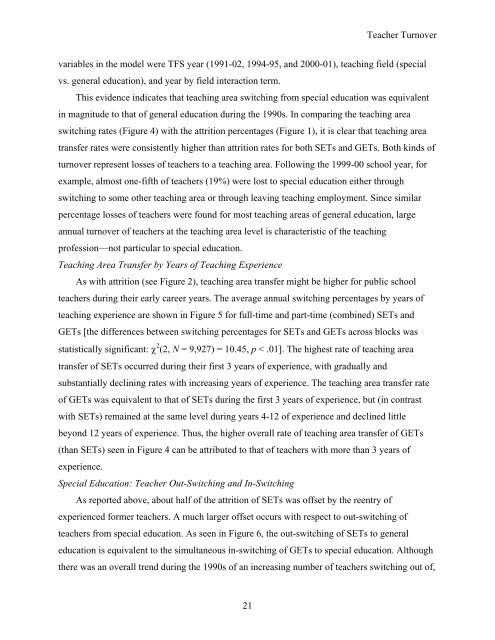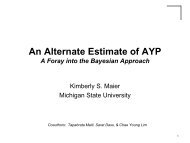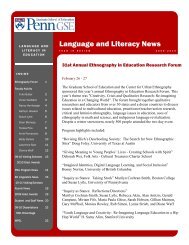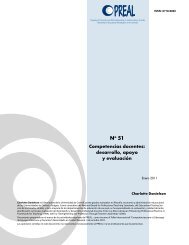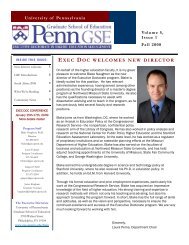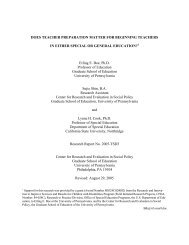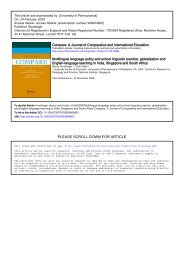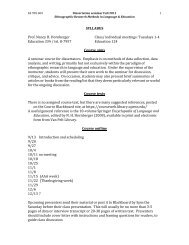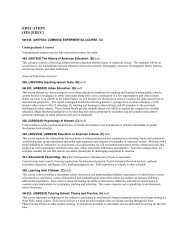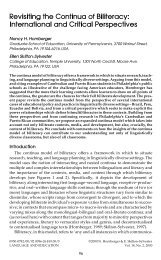Teacher turnover in special and general education: attrition
Teacher turnover in special and general education: attrition
Teacher turnover in special and general education: attrition
Create successful ePaper yourself
Turn your PDF publications into a flip-book with our unique Google optimized e-Paper software.
<strong>Teacher</strong> Turnover<br />
variables <strong>in</strong> the model were TFS year (1991-02, 1994-95, <strong>and</strong> 2000-01), teach<strong>in</strong>g field (<strong>special</strong><br />
vs. <strong>general</strong> <strong>education</strong>), <strong>and</strong> year by field <strong>in</strong>teraction term.<br />
This evidence <strong>in</strong>dicates that teach<strong>in</strong>g area switch<strong>in</strong>g from <strong>special</strong> <strong>education</strong> was equivalent<br />
<strong>in</strong> magnitude to that of <strong>general</strong> <strong>education</strong> dur<strong>in</strong>g the 1990s. In compar<strong>in</strong>g the teach<strong>in</strong>g area<br />
switch<strong>in</strong>g rates (Figure 4) with the <strong>attrition</strong> percentages (Figure 1), it is clear that teach<strong>in</strong>g area<br />
transfer rates were consistently higher than <strong>attrition</strong> rates for both SETs <strong>and</strong> GETs. Both k<strong>in</strong>ds of<br />
<strong>turnover</strong> represent losses of teachers to a teach<strong>in</strong>g area. Follow<strong>in</strong>g the 1999-00 school year, for<br />
example, almost one-fifth of teachers (19%) were lost to <strong>special</strong> <strong>education</strong> either through<br />
switch<strong>in</strong>g to some other teach<strong>in</strong>g area or through leav<strong>in</strong>g teach<strong>in</strong>g employment. S<strong>in</strong>ce similar<br />
percentage losses of teachers were found for most teach<strong>in</strong>g areas of <strong>general</strong> <strong>education</strong>, large<br />
annual <strong>turnover</strong> of teachers at the teach<strong>in</strong>g area level is characteristic of the teach<strong>in</strong>g<br />
profession—not particular to <strong>special</strong> <strong>education</strong>.<br />
Teach<strong>in</strong>g Area Transfer by Years of Teach<strong>in</strong>g Experience<br />
As with <strong>attrition</strong> (see Figure 2), teach<strong>in</strong>g area transfer might be higher for public school<br />
teachers dur<strong>in</strong>g their early career years. The average annual switch<strong>in</strong>g percentages by years of<br />
teach<strong>in</strong>g experience are shown <strong>in</strong> Figure 5 for full-time <strong>and</strong> part-time (comb<strong>in</strong>ed) SETs <strong>and</strong><br />
GETs [the differences between switch<strong>in</strong>g percentages for SETs <strong>and</strong> GETs across blocks was<br />
statistically significant: χ 2 (2, N = 9,927) = 10.45, p < .01]. The highest rate of teach<strong>in</strong>g area<br />
transfer of SETs occurred dur<strong>in</strong>g their first 3 years of experience, with gradually <strong>and</strong><br />
substantially decl<strong>in</strong><strong>in</strong>g rates with <strong>in</strong>creas<strong>in</strong>g years of experience. The teach<strong>in</strong>g area transfer rate<br />
of GETs was equivalent to that of SETs dur<strong>in</strong>g the first 3 years of experience, but (<strong>in</strong> contrast<br />
with SETs) rema<strong>in</strong>ed at the same level dur<strong>in</strong>g years 4-12 of experience <strong>and</strong> decl<strong>in</strong>ed little<br />
beyond 12 years of experience. Thus, the higher overall rate of teach<strong>in</strong>g area transfer of GETs<br />
(than SETs) seen <strong>in</strong> Figure 4 can be attributed to that of teachers with more than 3 years of<br />
experience.<br />
Special Education: <strong>Teacher</strong> Out-Switch<strong>in</strong>g <strong>and</strong> In-Switch<strong>in</strong>g<br />
As reported above, about half of the <strong>attrition</strong> of SETs was offset by the reentry of<br />
experienced former teachers. A much larger offset occurs with respect to out-switch<strong>in</strong>g of<br />
teachers from <strong>special</strong> <strong>education</strong>. As seen <strong>in</strong> Figure 6, the out-switch<strong>in</strong>g of SETs to <strong>general</strong><br />
<strong>education</strong> is equivalent to the simultaneous <strong>in</strong>-switch<strong>in</strong>g of GETs to <strong>special</strong> <strong>education</strong>. Although<br />
there was an overall trend dur<strong>in</strong>g the 1990s of an <strong>in</strong>creas<strong>in</strong>g number of teachers switch<strong>in</strong>g out of,<br />
21


